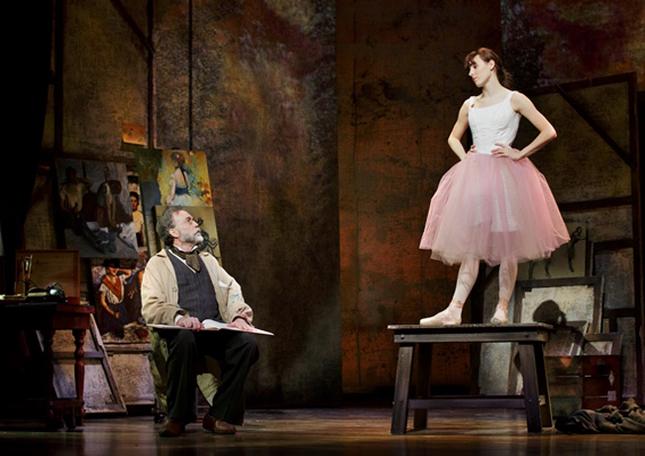‘Little Dancer’: a Perfectly Executed, Magical Musical
By • December 4, 2014 0 1780

“Little Dancer,” the ravishing,from-the-ground-up, entirely original Kennedy Center musical with Broadway hopes has finally had its official opening—and not a moment too soon.
In the age of Disney and Spiderman, “Little Dancer” is a musical that’s about something—in fact, several things, that matter. The musical, a radically and beautifully imaginative example of the form, tells the tale of a wispy, but gritty, adolescent, one-step-from-the-gutter aspiring ballerina in the La Belle Epoch Paris Opera Company who inspired Impressionist painter and sculptor Eduard Degas to create one of his most enduring works, the sculpture “Little Dancer Aged Fourteen” (now the center of a mini-exhibition at the National Gallery of Art).
Carrying on that idea of inspiration, everyone involved in this production seems to have been inspired into daring acts of the imagination. This is as show about art—not just the ballet and ballet dancers—but also artists and their work, famous ones including Degas, and his good friend, the American expatriate impressionist Mary Cassatt. Like “Follies,” a revival of “Ragtime” and the currently on-Broadway “Sideshow,” “Little Dancer” is a Kennedy Center production. All are marked by originality of a sort that you rarely encounter in musical theater.
Factually, we know that a 14-year-old girl named Marie van Goethem was the model for the Degas sculpture and that she was a member of the dance troupe, one of the so-called “rats,” young girls dragged up from the depths of poverty to fill the ranks of the corps de ballet, girls often the focus of predatory toffs in black top hats and tuxes who prowled backstage. The real Marie disappeared from history only to have a kind of forever re-incarnation in the form of the famous sculpture. “Little Dancer” purports to tell how this journey across time happened.
A terrific team has been assembled to make this enterprise a success. A passion for dance, for instance, obviously fuels director Susan Strohman, who gave us the wonderful dance show, “Contact,” a number of years ago. “Little Dancer” is in the end about movement, from the mobile and dazzling sets of Beowulf Boritt, to the keenly sharp and detailed, and pleasure-inducing moments when we see the dancers truly dance. It’s about getting from here to there, from mind-to-heart, from song to feeling. Lyricist Lynn Ahrens and composer Stephen Flaherty have come up with a book and songs and music that define the show and is in service to the story, smart, witty, empathic and passionate, reminiscent of their work on “Ragtime.”
The focus of “Little Dancer” is Marie, and in the elfin, dynamic American Ballet Theatre star Tiler Peck, the show has found its heart, its dazzler, who embodies all of Marie’s hopes, fears, dreams and travails. When she takes to the air, the show goes right with her. Small and beautiful, she still has the look of an urchin on the verge of becoming a special artist. Some observers have grumbled that she’s neither a singer or an actress. I beg to differ—her singing more often than not is of the sort that’s folded into duets or groups and doesn’t need to stand out, but her acting, that’s another matter. Peck acts the way dancers act—with their bodies, with their moves and movements, and Peck surely does this with her dances (she has the hang time of Michael Jordan at apogee), which illustrates human aspirations of flight. But she carries this over into what Marie does—she’s never still. Some part of her body—expressive face, butterfly hands, fluttery feet and legs, head out or down—some expression and emotion is making its move. Only when she poses for Degas—for drawings, sketches and the sculpture itself does she become peaceful, attaining some sort of sense and picture of herself.
The production and all of its aspects paints a gaudy, detailed picture of Paris in the Impressionist age. The sets have aspects of paintings, and it achieves something remarkable—you can get giddy watching that world, without being able to ignore its harsher aspects. That would be the plight of Marie’s alcoholic laundress mother, the deflating punch of poverty without hope, the prowling men in their silk hats, the overbearing patrons of the arts.
That world is the world of Degas, too, who was obsessed with painting the world and its inhabitants. He takes an interest in Marie after she steals his watch and has her pose for him. Ultimately, Degas starts to lose his sight and despairs of painting. The pushy Marie says, “Why don’t you use your hands?”
Throughout , there is an older, more imagined Marie, dressed in middle class finery, who has returned to her beginnings upon the death of Degas, wanting to find out what happened to the sculpture which she’s never seen. Broadway veteran Rebecca Luker makes her a warm, and fine-voiced presence. She’s our guide through Marie’s world and her own past.
Boyd Gaines as Degas gives a sharp portrait of a genius at work and his relationship with Marie. He is inspired but also maddened by her and determined to show people and things as they are without having to prettify Marie.
In all its components and parts, “Little Dancer” sweeps you up, carries you along and brings you to where we are today in a theatrical way that at its end is such a pleasurable, generous act of magic—a perfect execution of an act of arrival and ending that shines.
“Little Dancer” is at the Kennedy Center’s Eisenhower Theater through Nov. 30.
- Boyd Gaines and Tiler Peck in Little Dancer. | Paul Kolnik





